PMI-CP as a Strategic Tool in the QualityPMO Toolkit for Mega Construction Projects
The PMI Construction Professional (PMI-CP) certification is emerging as a pivotal credential for navigating the complexities of today’s mega construction projects. While traditional project management certifications offer a foundation in planning and coordination, PMI-CP fills a critical gap—translating best practices into field-executable systems that integrate scope, change, quality, and risk into one continuous performance assurance model.
The Quality Project Management Office (QualityPMO) methodology—built on principles of system thinking, digital transformation, and Lean-BIM integration—offers a powerful operational framework to apply PMI-CP tools in real-world settings. PMI-CP is not a replacement for PMBOK or PMP-based principles. Instead, it builds upon them by embedding construction-specific competencies that drive predictable, quality-focused, and digitally-enabled delivery.
This article is based on Dr. Emari’s presentation on Thursday, May 22, for the PMI Chicagoland Construction PM SIG event!
Listening in Color: Diversity, Empathy, and the Art of Construction Management
The CPMP philosophy begins with recognizing diversity of thought, responsibility, and systems. Like a color wheel, every stakeholder offers a distinct contribution to the full spectrum of a project’s success. Drawing from the philosophy shared in the opening of the QualityPMO presentation, effective project professionals must learn to “listen in color,” appreciating each interface, risk, and discipline as a vital voice in the broader construction dialogue.

This mindset is essential in managing high-stakes capital projects where active listening, stakeholder empathy, and culturally aware leadership influence everything from interface alignment to contract clarity.
Transforming Construction Quality Through PMI-CP and Digital PMCM
Construction projects are often hampered by fragmentation, siloed teams, reactive issue management, and underutilized digital systems. According to CII, over 70% of construction projects face time or cost overruns—not because of complexity alone, but due to poor interface coordination, lack of quality integration, and gaps in real-time visibility.
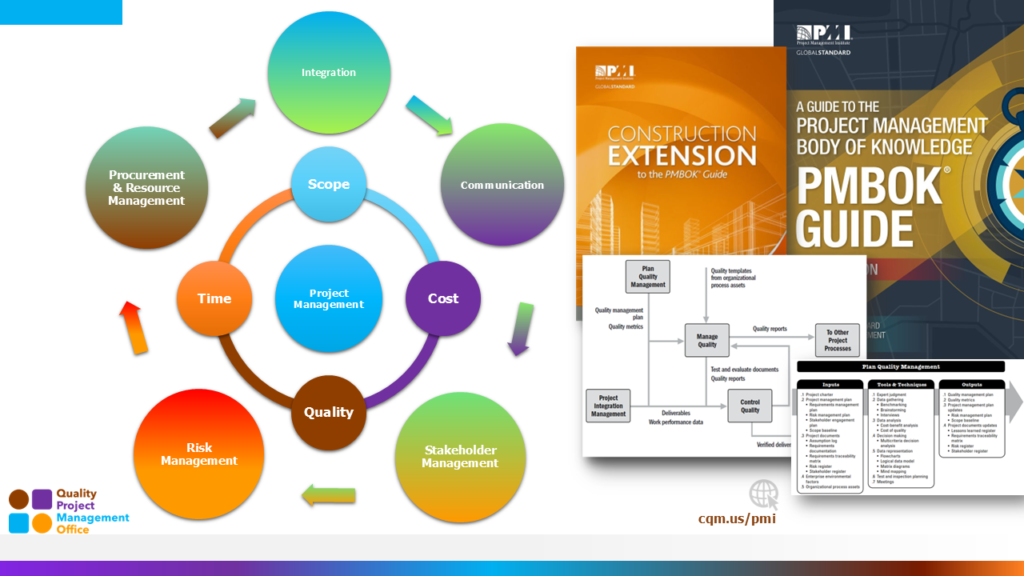
PMI-CP, integrated within the QualityPMO model, addresses these gaps by promoting a culture of proactive risk mitigation, interface transparency, and stakeholder alignment. It introduces field-tested, digital-first tools to break silos and establish continuous feedback loops between the office, the field, and the owner.
PMI-CP Module Integration with the QPMO Framework
Module 1: Interface Management
Missed interfaces—between disciplines, trades, and systems—are a primary cause of delays and rework in capital construction. PMI-CP’s Interface Management module equips professionals with a structured approach to identifying, assigning, and tracking interface risks.
In the QPMO framework, this module aligns with Construction Industry Institute (CII) tools such as the Interface Management Tool and PIRI Matrix, but is transformed into digital, visual workflows. These are particularly critical in system-centric environments like SCADA or rail traction power, where precise handoffs and sequenced integration are essential.
Impact: Enables real-time interface alignment, proactive mitigation, and resilient multi-discipline coordination.

Module 2: Scope, Cost & Change Control
Unmanaged change can quickly cascade into cost overruns, schedule delays, and stakeholder conflict. This module introduces governance tools that track scope changes, align contractual responsibilities, and link time-cost-quality trade-offs.
The QPMO approach incorporates these concepts into digital dashboards using tools such as Oracle Primavera, Unifier, and BIM-integrated workflows. Scope change impact is visualized and aligned with Lean constraints, facilitating early alignment with owners and field teams.
Impact: Prevents downstream failures by structuring change management across the project lifecycle.
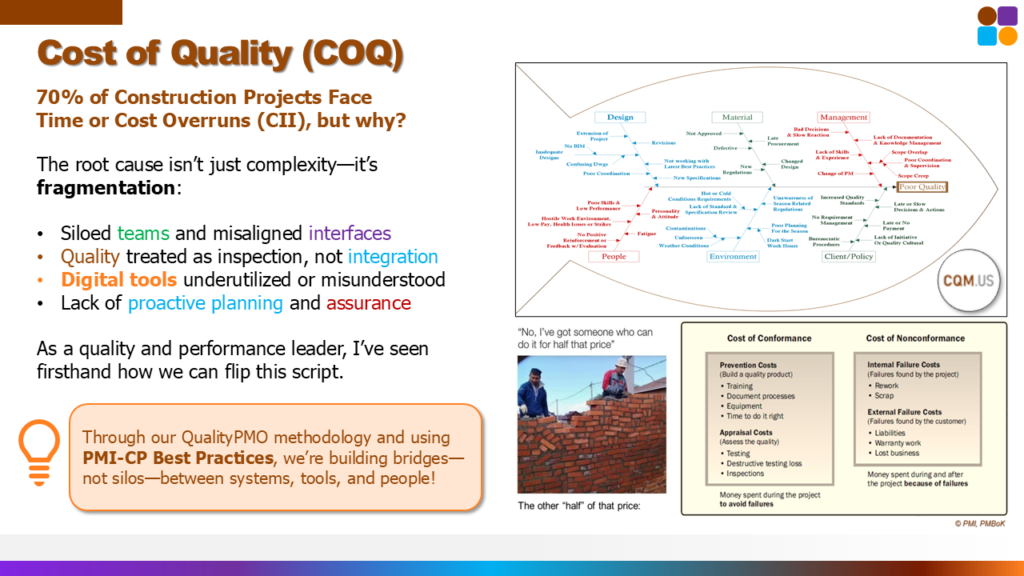
Module 3: Risk & Opportunity Management
Risk management in construction is no longer confined to safety checklists or end-stage reviews. This module emphasizes proactive risk ownership, integrating tools like bow-tie analysis, procurement event tagging, and real-time mitigation tracking.
By embedding risk registers and mitigation ownership into daily planning and reporting workflows, QPMO transforms uncertainty into a platform for smarter decision-making.
Impact: Enables foresight-driven delivery through predictive insights and risk-informed planning.

Module 4: Digital Collaboration Tools
Effective collaboration in construction requires more than meetings—it demands a system-wide digital backbone. PMI-CP’s module on Digital Collaboration Tools & PMIS emphasizes data integration, version control, and real-time responsiveness across stakeholders.
The QualityPMO framework leverages platforms such as Procore, Primavera Cloud, and Oracle Unifier to connect daily logs, RFIs, quality workflows, and approvals across office and field teams. These tools ensure that everyone—from subcontractors to owner representatives—operates with a single source of truth.
Impact: Strengthens accountability, transparency, and agility by embedding data into the decision-making fabric of the project.
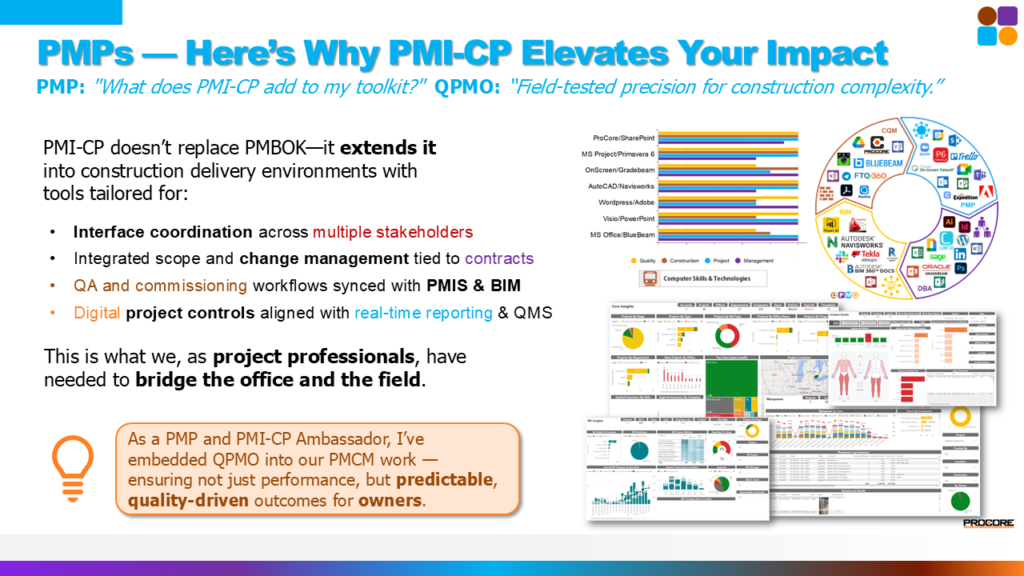
Module 5: Contracting Strategy
Contracts are more than legal instruments—they are frameworks for collaboration. PMI-CP reframes contracting strategies to promote early stakeholder engagement, shared risk, and integrated performance tracking.
Through QPMO, contract types such as CMAR, IPD, and Progressive Design-Build are aligned with project objectives and field realities. Stakeholder incentives are integrated into performance-based contracts using Target Value Delivery and partnering agreements.
Impact: Contracts become tools for alignment and trust, supporting Lean collaboration and quality assurance from the outset.
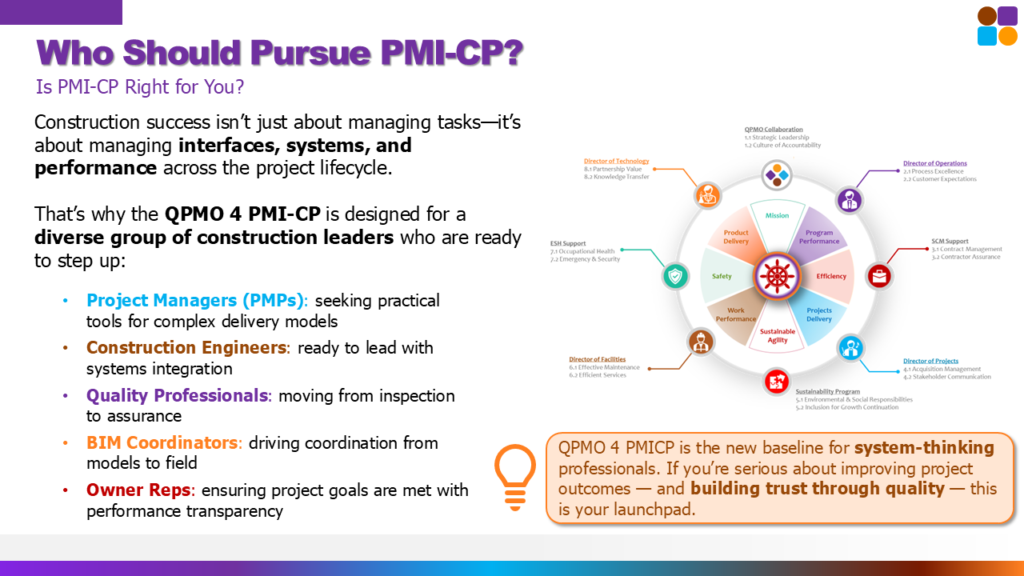
Module 6: Quality in Execution
Traditionally, quality in construction is managed through inspections and checklists. PMI-CP shifts this paradigm—quality is treated as a real-time operating system. Early integration of Inspection and Test Plans (ITPs), field-level digital tracking, and milestone-aligned QA checkpoints are central to this module.
The QPMO system ensures QA workflows are digitally connected to scope changes, interface milestones, and contractual deliverables. Real-time QA visibility supports daily decision-making, enabling faster root cause analysis and continuous learning.
Impact: Moves quality from reactive inspection to integrated assurance, reducing rework and building trust in the delivery process.

Lean Thinking and PMI-CP: A Shared Language
Lean Construction principles—such as pull planning, constraint management, and flow efficiency—are reinforced through PMI-CP’s structured toolsets. The QPMO approach combines Lean with PMI-CP to enable:
- Target Value Delivery (TVD) for aligning scope and budget early
- Interface Management to break down silos across trades and systems
- Transparent Change Control as a mechanism for mutual accountability
- Continuous Improvement Loops based on feedback and analytics
Impact: Embeds a collaborative language of performance that aligns the field, the office, and the owner.
BIM as a Quality Communication Platform
BIM’s role in QualityPMO goes beyond design coordination. When integrated with PMI-CP tools, BIM becomes a QA communication hub:
- Links QA/QC checkpoints to the 3D model
- Visualizes ITPs and inspection workflows
- Enables 4D sequencing for system commissioning
- Tracks digital as-builts and field updates in real time
Especially in rail, power, and safety-critical systems, BIM-integrated QA ensures seamless coordination between digital intent and field execution.
Impact: Transforms BIM into a living quality platform—where models don’t just represent structures, but track performance delivery.
From Data Collection to Decision Intelligence
PMI-CP promotes the evolution from fragmented data collection to integrated decision support systems. QualityPMO incorporates Oracle, Procore, Textura, and Unifier to build Business Intelligence (BI) dashboards that:
- Visualize QA checklists, cost impacts, and schedule risks
- Highlight interface bottlenecks and procurement dependencies
- Empower owner-side visibility for real-time assurance
- Tie lessons learned and performance data into continuous improvement loops
Impact: Delivers smarter, safer, and faster decisions through integrated digital workflows and performance insights.
Beyond Tools: Integrating PMI-CP into Organizational Frameworks
The full value of PMI-CP emerges when its modules are embedded within a broader, systems-thinking approach to organizational delivery. The QualityPMO framework is not just a set of workflows—it is a management philosophy that aligns tools, processes, culture, and performance assurance.
This section highlights how PMI-CP supports and is enhanced by five strategic organizational models used in complex capital projects.
EMARI System Thinking: Engineering, Managing, and Reinventing Integration
PMI-CP aligns seamlessly with the EMARI system-thinking framework, which emphasizes cross-functional integration between:
- Engineering assurance
- Project management coordination
- Architectural system design for ownership alignment
EMARI reinforces that quality is not a checklist but a strategic capability built on interconnected systems, digital intelligence, and informed decision-making.
Impact: Elevates PMI-CP from a project-level credential to an enterprise-wide performance system by uniting technical and managerial domains.

CPMP: Construction Project Management for Owner Performance Assurance
As capital projects grow in complexity, owners require more than periodic reports—they need real-time visibility into performance, risk, and quality.
Through CPMP (Construction Project Management Professionals), the QPMO model integrates PMI-CP modules into smart dashboards, independent verification systems, and field-to-executive feedback loops. Owner representatives benefit from structured reporting on:
- QA metrics and nonconformances
- Contract and schedule risk
- Root cause insights
- Predictive analytics on interface breakdowns
Impact: Enhances owner trust and transparency, enabling proactive decisions that align with project goals and stakeholder commitments.

CMBIM: Advancing Digital Maturity in Construction QA
CMBIM (Constructive Minds for BIM Integration and Maturity) extends PMI-CP’s digital philosophy by defining where each project lies on the QA digital maturity curve:
- Reactive QA: Manual, paper-based inspections
- Proactive QA: App-based forms and dashboard visibility
- Predictive QA: AI-enabled issue tracking, feedback analytics, and BIM-ITP integration
By embedding PMI-CP practices in digital workflows, the QPMO framework uses BIM as a live QA and commissioning system, enhancing predictive control and field visibility.
Impact: Fosters a mature, digitized quality culture that continuously learns and improves from real-time project data.

WQM: Wellness Quality Management and Human & Organizational Performance
PMI-CP also supports a human-centered transformation through WQM (Wellness Quality Management), which applies Human and Organizational Performance (HOP) principles to construction:
- Promotes psychological safety for issue reporting
- Prioritizes learning over blame
- Uses near-misses and incidents as signals of system failure—not individual fault
- Emphasizes empathy, trust, and collaborative improvement
WQM provides the cultural foundation for PMI-CP implementation, ensuring that digital and process tools are paired with humane leadership and empowered teams.
Impact: Builds a resilient organizational culture where performance thrives not in spite of people, but because of them.
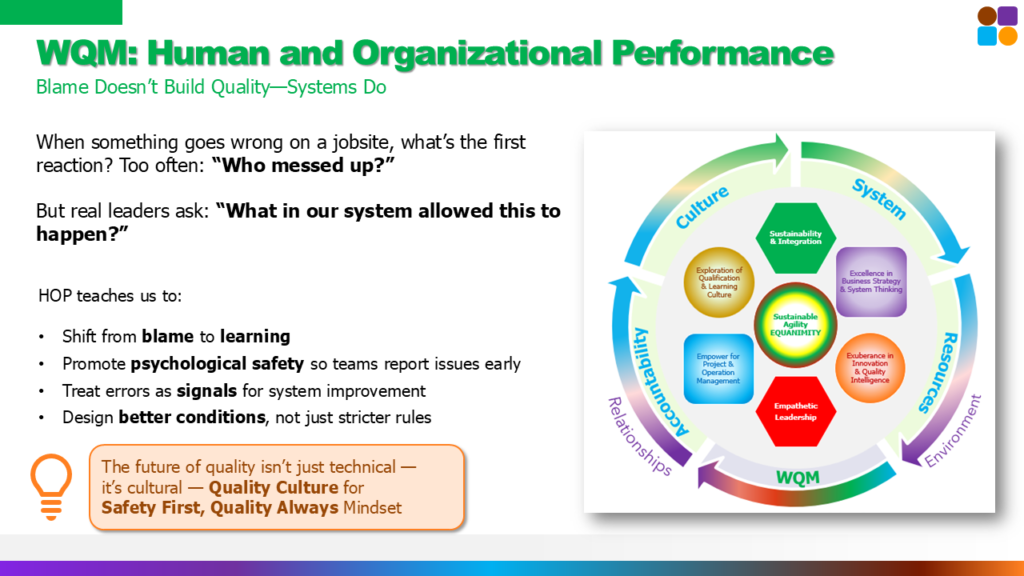
SLAC: Strategic Leadership for Assurance & Compliance
“Lessons learned” are often neglected or filed away. In the SLAC model, feedback loops become strategic leadership tools, not afterthoughts. PMI-CP’s emphasis on risk, quality, and change control feeds directly into:
- Digitally tagged issue logs
- Categorized risks by trade/system
- Phase-based learning reviews
- Future-phase planning sessions
SLAC reframes compliance and assurance as a collaborative, forward-looking process, rather than a policing function.
Impact: Ensures projects learn from themselves and institutionalize wisdom, accelerating organizational excellence.
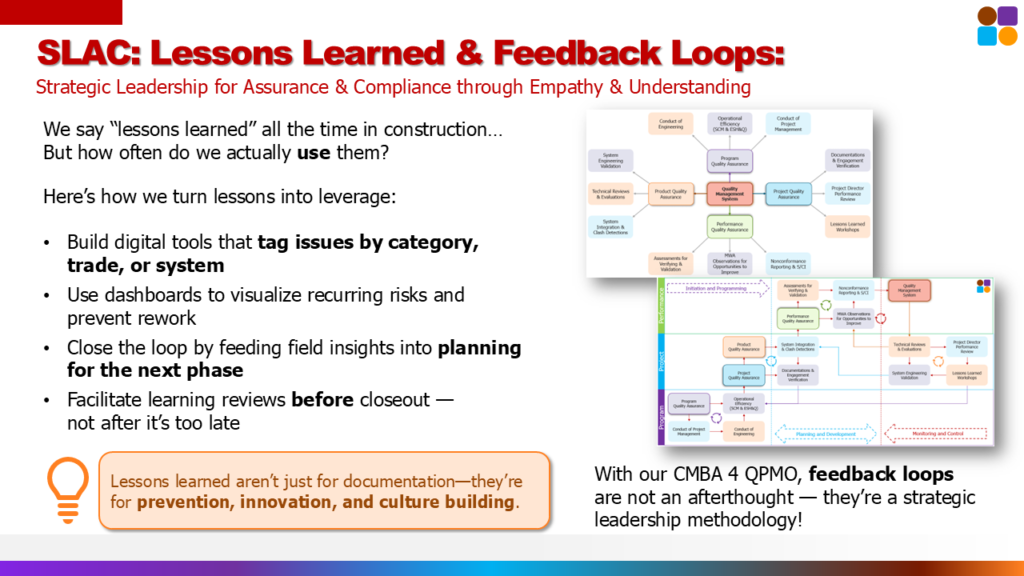
Conclusion: PMI-CP as a Platform for Project and Organizational Excellence
When fully implemented within the QPMO methodology, PMI-CP is more than a professional certification—it becomes a scaffold for quality delivery, a language for collaboration, and a platform for digital transformation.
Through strategic integration with frameworks like EMARI, CPMP, CMBIM, WQM, and SLAC, PMI-CP drives:
- Smart tools for field execution
- Cultural foundations for team empowerment
- Strategic assurance for owner confidence
Construction Project Management Professionals (CPMPs) who adopt PMI-CP as part of a broader quality-driven system will be equipped to lead with precision, empathy, and insight—delivering not just buildings, but outcomes that perform.